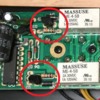So, OGR being a discussion forum, let's discuss!  The expedient "solution" is to just replace the Rev2 E-unit with one that has a plug-and-play lockout switch. But where's the fun in that.
The expedient "solution" is to just replace the Rev2 E-unit with one that has a plug-and-play lockout switch. But where's the fun in that. 
So if we agree to the premise that the Rev2 E-unit stays, I see several alternatives to lockout. I offer my ramblings, a.k.a. 2-cents worth:
Option 1. Add a DPDT switch and an external $1 bridge rectifier. This requires no modification to the Rev2 board. The external bridge rectifier converts track AC to DC just like the on-board bridge rectifier(s). The DPDT switch selects between whether the DC-can-motor is driven by either (A) the Rev2 board with its reversing capacity, or (B) the DC bridge-rectifier output which locks the engine in a fixed direction. The gotcha may be that the $1 DPDT switch must be able to handle the 1-2 Amps or whatever Amps current the engine requires. Since your engine does not presently have reversing capability, I assume you'd need to cut a hole in the chassis to access the lockout switch so this could mean a slightly larger cut-out than a typical lockout switch (e.g., the type proposed by Wbb for their Rev4 board) which only carries a fraction of an Amp of current.
Option 2. Same as above but "steal" the DC voltage from the on-board bridge rectifier. Still need a DPDT switch that can carry the DC motor current but saves the cost of the external bridge rectifier. So this would require finding someplace on the PCB to solder 2 wires that represent the DC output of a bridge rectifier.
Option 3. Reverse-engineer how the 2 relays are driven to "force" them to be in the Forward position.

This is mere speculation, but my guess is the 4 states (F-NBR-R-NBF, NB=Neutral Before) of the E-unit map to the 4 possibilities of the 2 relays. Each relay is driven by what is in effect an "on-off" transistor as circled in red. If the lockout switch could force the 2 transistors to whichever on-off condition to make the relays drive the motor to the Fwd direction then we're done! The currents involved with the transistors are minimal when compared to the Amps of current when dealing with the motor currents themselves. So the lockout switch could be a smaller, less-expensive, double-pole switch. The switch would either allow the transistors to be driven by (A) the existing circuit, or (B) by some circuit which "forces" the transistors to the desired on-off states. This may require a few 10 cent diodes/resistors. This would also involve some study of how the transistors and nearby components are interconnected which means sketching out the interconnections of the traces on the front and back of the PCB.
Option 4. The available Rev4 WBB diagrams suggest the magic IC chip is the 4017. This is an inexpensive 50 cent digital counter chip which counts 1,2,3,4,1,2,3,4,1,2,3,4, etc. to cycle thru the 4 possibilities of F,NBR,R,NBF, F,NBR,R,NBF, F,NBR,R,NBF, etc. You might want to confirm that the Rev2 IC chip has the marking "4017".

So in this option, the idea would be to force the 4017 counter IC to remain at a fixed count (whether it be 1,2,3, or 4)...whichever corresponds to the Forward motor state. This also requires documenting the interconnections on the front and back of the PCB; there are certain pins of the 4017 which are more relevant so you wouldn't have to document everything. But like option 3, the lockout switch would only be carrying low-current signals (vs. high-current motor power). Like option 3, this may require additional of a few 10-cent diodes or resistors. So in this case the lockout switch would select between (A) letting the counter IC chip advance 1,2,3,4,1,2,3,4,etc. every time the track power vanishes-and-re-apprears (pressing the transformer Direction button), or (B) blocking the counter IC from "seeing" the track power interruptions.
----
Separately, I believe what you're seeing with the modified Rev2 PCB running in Forward for only 1 second and then stopping forever is simply the counter IC chip advancing from Forward to Neutral-Before-Reverse and then sticking in the NBR state forever.










